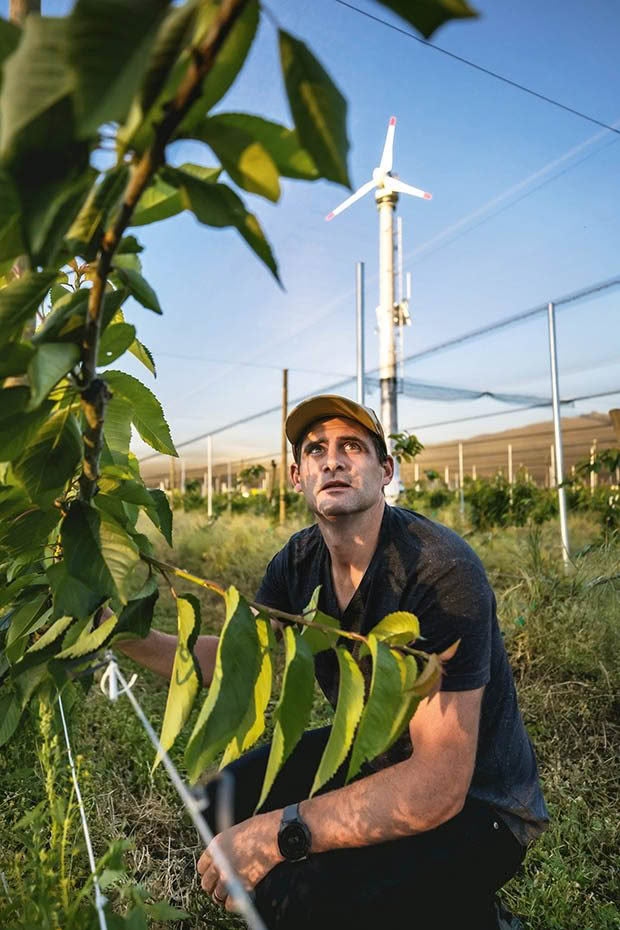Cromwell’s electric-operated cherry orchard is changing the produce game

After proving he could run a cherry orchard without burning a single fossil fuel, Mike Casey is keen to move other growers towards electric tech.
Words: Claire Finlayson Photos: Thomas Green Miles Holden
When Mike Casey sold a successful software start-up in Sydney and became a Cromwell cherry farmer, his former colleagues weren’t surprised. “They thought, ‘That’s pretty much Mike’s MO: to go and do something insane,’” he says. Insane, because he had a profound lack of horticultural nous. That lack turned out to be an asset, forcing him to think outside the square. Three years on, he’s at the helm of the world’s first 100 per cent electric, zero-fossil-fuel commercial orchard: Forest Lodge.
Mike returned to New Zealand in 2019 with a young family in tow, a cashed-up entrepreneur determined to use his capital to help fight climate change. He and his wife Rebecca bought six hectares of land, planted 9300 cherry trees, and smiled at the thought of the 3.8 tonnes of carbon those trees would sequester annually. “I was naïve enough to think that was all I’d need to do to create a carbon sink.” After a few back-of-the-envelope calculations, he clocked the dirty diesel debt his productive orchard would rack up: 60 to 80 tonnes of annual carbon emissions.
As the electrical revolution was still in its infancy in New Zealand, Mike had to think creatively. “Instead of looking at a ‘blocker’ and thinking ‘that’s impossible’, I see it as a challenge.” The first electric triumph was swapping the orchard quad bike for an electric golf cart from China (fitted with off-road tyres and raised suspension). Other electric imports followed, including a mower from the United States and frost-fighting fans from South Africa. He’s now awaiting delivery of a driver-optional tractor from California.

Mike installed a solar and battery system to run the irrigation. But as it worked well only 90 per cent of the time and produced excess unused generated power, he decided to connect to the national grid and shun the onsite use of fossil fuels entirely. “It cost us $150,000. We had to pay that up-front just to start electrifying.” It was a gutsy financial move that required capital and foresight. “The full payback period for everything I’ve done in electrification is about eight years, but if I achieve a 15 per cent premium with my cherries, I’ll bring it down to 18 months.” That premium was market-tested in January 2022 with the first Forest Lodge cherry harvest. At a petite two tonnes, it would have proved uneconomical to pick were it not for a grant from the Agricultural and Marketing Research and Development Trust. This allowed Mike to price-trial at selected Farro Fresh supermarkets. He sold those first cherries for three times the price of others on the market and shifted the same volume.
Turnover for that first crop was $26,875 (wholesale), with a heartening grower return of $13.80 per kilo. Much of this season’s crop will go to a buyer in Taiwan, and online pre-sales will mostly snap up the rest. Come summer 2025-26, and the Forest Lodge cherry yield should reach 100(ish) tonnes.
A different kind of Mike might have guarded this competitive edge. But this Mike is an agricultural torch bearer for the Net Zero 2050 goal. To this end, he co-founded New Zealand Zero (NZ0) to build the certification and brand associated with zero-fossil-fuel farming. “I wanted to be the first independent grower for a much bigger movement. I will not solve the climate crisis by only doing this myself. We have to change how we think of business from being protective to being collaborative in many ways.”
With orchard manager/co-owner Euan White looking after day-to-day operations at Forest Lodge, Mike can focus on NZ0. This means walking the talk with farmers rather than sitting in an office telling them what to do. “I’m sharing all my numbers – what I spent my capital on, what the cost savings were – to de-risk it for them. At the end of
the day, the only way we’ll solve the climate crisis is if we prove to growers that electric tech is far superior from a bottom-line perspective as well.”
HEADWINDS
“Access to technology that doesn’t yet exist here. A lot of what we’re doing is either sourcing it from around the world or building it ourselves.”
TAILWINDS
“Being able to rely on neighbours, friends and experts in horticulture to grow delicious cherries. What I’m doing in return is bringing a whole new angle to farming.”
WHAT’S NEXT?
“Forest Lodge’s goal is to grow really good cherries. NZ0’s goal is to scale what Forest Lodge has done. I want it to be the platinum standard for food production in New Zealand.”
NUMBERS
$216k – cost of solar and battery system
$150k – connection to the grid
$900 – current annual energy bill
$25k – amount saved annually from energy set-up
60 tonnes – carbon saved annually through electrification
Find out more about Forest Lodge here.
Love this story? Subscribe now!
 This article first appeared in NZ Life & Leisure Magazine.
This article first appeared in NZ Life & Leisure Magazine.
